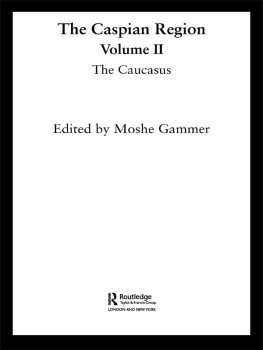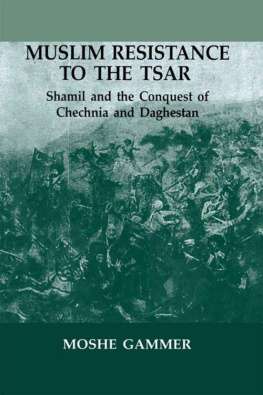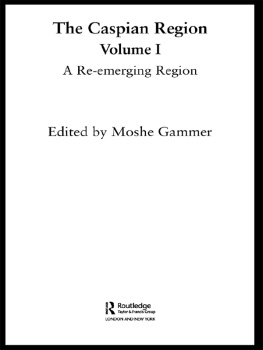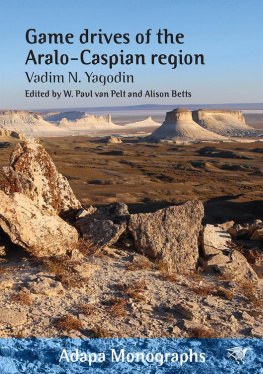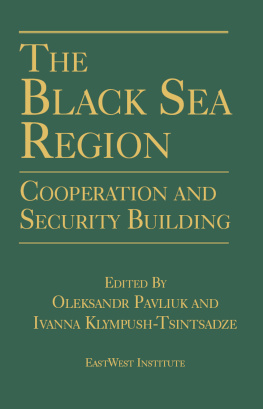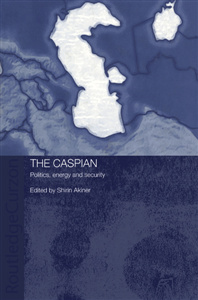The Caspian Region
Volume II
The Caucasus
Edited by Moshe Gammer
The Caspian Region
Volume II
The Caucasus
Edited by Moshe Gammer
First published 2004 by Routledge
11 New Fetter Lane, London EC4P 4EE
Simultaneously published in the USA and Canada
by Routledge
29 West 35th Street, New York, NY 10001
Routledge is an imprint of the Taylor & Francis Group
This edition published in the Taylor & Francis e-Library, 2004.
2004 Moshe Gammer for selection and editorial matter; individual contributors their contribution
All rights reserved. No part of this book may be reprinted or reproduced or utilised in any form or by any electronic, mechanical, or other means, now known or hereafter invented, including photocopying and recording, or in any information storage or retrieval system, without permission in writing from the publishers.
The publisher makes no representation, express or implied, with regard to the accuracy of the information contained in this book and cannot accept any legal responsibility or liability for any errors or omissions that may be made.
British Library Cataloguing in Publication Data
A catalogue record for this book is available from the British Library
Library of Congress Cataloging in Publication Data
A catalog record for this book has been requested
ISBN 0-203-00512-0 Master e-book ISBN
ISBN 0-714-65248-2 (Print Edition)
Maps
The Caspian Region
Georgia: Administrative Division
The Northern Caucasus: Administrative Division
The North-Western Caucasus: Ethnic Composition
Daghestan: Ethnic Composition
Daghestan: Administrative Division
Preface
The importance of the Caucasus lies in its being a crossroads between two seas and two continents. Furthermore, all the main present and planned pipelines for the transfer of Caspian oil and gas pass through this area or near it. However, the area has also been known for its instability, coups and violent wars such as those in Chechnya, Abkhazia, Nagorno-Karabakh, South Ossetia and between the Ingush and the Ossets. All these have received a great deal of publicity and are therefore deliberately omitted from this book. Rather, the intent is to bring to the readers attention other potential conflicts and those that have not been solved.
The Caucasus is now divided between the Russian Federation north of the main range and three independent states Armenia, Azerbaijan and Georgia south of it. Nevertheless, such a division is not easy to apply in analysis, since in reality the political borders do not correspond to geographical, economic and ethnic ones. A great many issues and relationships spill over beyond political borders and conflicts are in some cases interconnected. The conflicts in South Ossetia and Abkhazia, for example, are strongly connected to the Northern (Russian) Caucasus, while the war in Chechnya has affected both Georgia and Azerbaijan.
discusses a potential conflict that, if neglected or mishandled, might deteriorate into a second Nagorno-Karabakh.
The Northern Caucasus is ethnically one of the most diverse areas in the world. Nevertheless, all its aboriginal ethnic groups share a sense of affinity and cultural unity as mountaineers. Thus attempts at political unity are intertwined with disputes and conflicts. Part II discusses two such attempts at unity. analyses an attempt that seems so far to have failed to unite all the peoples of the Northern Caucasus in the Confederation of the Mountain Peoples of the Caucasus (which later changed its name to the Confederation of the Peoples of the Caucasus).
, on the other hand, deals with an attempt that so far seems to have been quite successful. At the same time it analyses a unique phenomenon of two (or even three) national movements of diaspora peoples, with the centre of one of them located in three separate autonomous republics and one autonomous district. It therefore also contains theoretical implications for the study of national movements, diaspora peoples and the relationships between centre and diaspora.
Part III is dedicated to Daghestan. This unparalleled ethnically diverse over 30 native ethnic groups inhabit it, in addition to some non-native ones autonomous republic of the RF belongs to 14 officially recognised nationalities. With galloping economic, social, national and political crises following the dissolution of the USSR, the transfer to a market economy and the semi-isolation caused by the wars in Chechnya, Daghestan has so far disappointed the frequent predictions that it would be the scene of the next conflagration. analyses the implications of national problems and conflicts in Daghestan for neighbouring entities and vice versa.
The last two chapters use Daghestan as a case study for reexamining larger issues connected to Islam. One is that of fundamentalist Islam, or Wahhabism, as it is dubbed in the FSU. With both the West and (to a lesser extent) Russia increasingly targeting fundamentalist Islam as their chief enemy, it has become fashionable for governments to call their enemies fundamentalists or Wahhabis in order to gain international sympathy, recognition, legitimisation and/or support. However, are all those so designated really fundamentalists, and do they pose a real threat? deals with these questions.
The last question is that of the complex, ambivalent relationship between Islam and nationalism. A great many studies have been published over the years discussing various areas of the world with a Muslim population, from the Arab world to the Indian sub-continent and South-East Asia. More recently the Muslim areas of the FSU, both outside and inside the RF, have been added to that list. is an important contribution to the description and analysis of this question.
Contributors
Dr Vladimir Bobrovnikov is Senior Research Fellow at the Institute of Oriental Studies of the Russian Academy of Sciences. He is the author of Custom, Crime and Ethnography among the North Caucasian Muslims(Moscow: Vostochnaya literatura; forthcoming) and of more than 80 articles and chapters on the contemporary history and anthropology of Muslim village community and customary law in the Northern Caucasus (Daghestan). He is working now on the English version of his above monograph.
Chen Bram is an applied anthropologist and social psychologist. He works as a consultant specialising in multiculturalism and in cross-cultural issues. He is a PhD candidate at the Hebrew University of Jerusalem. His dissertation deals with Multiculturalism and Ethnicity the case of the Mountain Jews in the Caucasus and in Israel. He is also engaged in research on the Circassians (Adighe) as a Diaspora people, in the Caucasus and in Israel, at the Truman Institute of the Hebrew University.
Dr Moshe Gammer is Senior Lecturer at the Department of Middle Eastern and African History at Tel Aviv University. He is the author of Muslim Resistance to the Tsar. Shamil and the Conquest of Chechnia and Daghestan(London: Frank Cass, 1994) and numerous articles and chapters on the modern and contemporary history of the Caucasus, Central Asia and the Middle East. In addition to this book he has edited Political Thought and Political History: Studies in Memory of Professor Elie Kedourie(London: Frank Cass, 2003).

